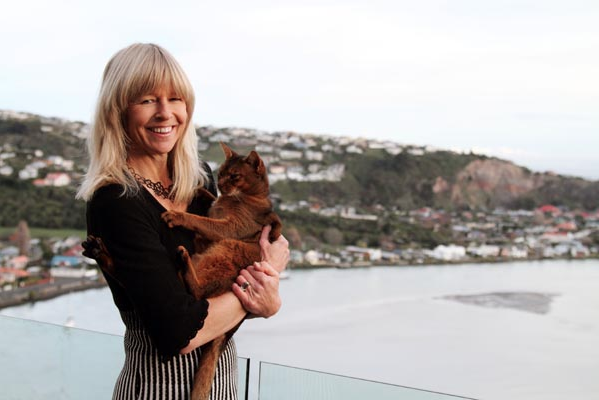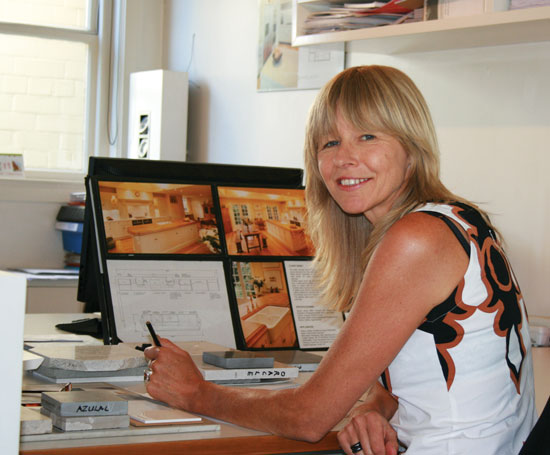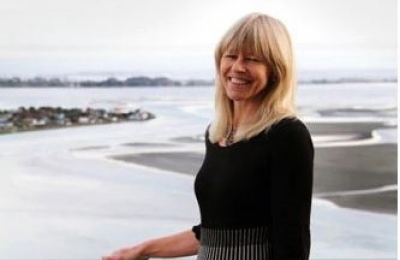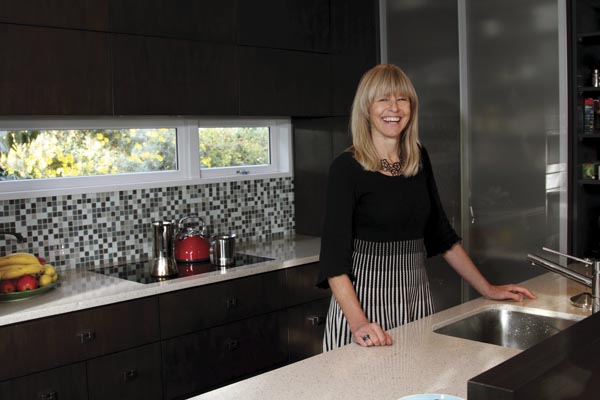Ingrid Geldof
26th September 2018
Who is Christchurch designer Ingrid Geldof outside the kitchen?
Designing a living....
In a Bealey Ave office, Ingrid Geldof turns homeowners' ideas into dream kitchens. It's something she has been doing since her mid 20s, after a sales role introduced her to kitchen design and her passion was ignited. Ingrid Geldof Design is a business Christchurch residents have been using to complete their homes since 1993. But there's more to this woman than kitchens, bathrooms and laundries.
Ingrid's smiling blue eyes peek out from beneath a long, straight fringe. Her slight frame is covered by a blue patterned top and black pants that elongate her legs. She is at ease in her surroundings - the labelled folders, computers and paperwork - and in hot demand, if the regular chirping of her phone is anything by which to judge. When we meet, she is fresh from an overseas trip that started with a wedding in the Blue Mountains in Australia and included the world-famous Milan Furniture Fair, a few days in Barcelona, a visit to a benchtop factory in southern Spain, a stop in Grenada and family time in the Netherlands. The 48-year-old is a busy woman.
Efficiency is key to her successful business, and something Ingrid views as important. She minimises waste in her life wherever possible, and puts her time to good use. During car trips, she'll play an audio-book, so she can learn something new while going about her errands.
As the daughter of Dutch immigrants Cornelis and Marijke, she believes their wartime experiences strongly influenced her upbringing. "They had gone through hard times and were both very aware of waste and being efficient," she says.
While Christchurch has always been Ingrid's home, her parents grew up in Friesland, a province in the northern part of the Netherlands - "where the Friesian cows come from". Marijke was a nurse and she met Cornelis when he was hospitalised with tonsillitis.
Cornelis, a painter, decorator and trained teacher, moved to New Zealand in 1952. He found work at the New Zealand Railways in Wellington, "painting give-way signs on the road and billboards" and he even painted a picture of the Queen for the 1953-54 tour soon after her coronation. His romance with Marijke was maintained through letters, until she joined him, nine years later.
Cornelis started his own painting and decorating business in Wellington and ran this until 1964, when he was asked to run Christchurch Polytechnic's first painting and decorating course. By this stage, the couple had two daughters, Emieke and baby Ingrid.
Ingrid says her creativity stems from both sides of the family. During Marijke's time as a geriatric nurse in Christchurch, she would draw the elderly residents with pastels, and most of the artworks were given to their family members. Ingrid has only photos of the 150 pieces, but has her parents' letters and Marijke's diaries and poetry, too.
Ingrid doesn't keep a diary, or write like her mother, but spends her spare time reading technical books to learn about technology, hardware and how things work.
"I just like the technical aspect of what I do. It's more a boy thing. I always like to understand how things work. I've always had a propensity to understand and take things apart until I know how to put them back together."
It makes sense, then, that the biggest compliment about a kitchen she can receive is: "I really love it because it is so easy". It also helps explain why many of the 1000 photos Ingrid took during her third visit to the Milan Furniture Fair are of hinges, light fittings, tapware, and the like.
Ingrid says New Zealanders favour traditional design when it comes to kitchens. With an additional designer in Queenstown and a contract draftsperson in Wellington, she often develops a Quaker-style look, which is simple, yet elegant, for clients.
"There's nothing ornate about it. It can be beautiful. We can do some gorgeous stuff, because we've got very talented joiners here [who] can do some really nice things."
The six-day Milan Furniture Fair is an opportunity to see the world's interior design trends on display. Ingrid was among the 300,000 people who passed through the event's doors and says the number of Kiwi designers who attended reflects the high standard of design in New Zealand.
"There would have been 40 New Zealanders over there, looking at the show, which is a huge percentage of designers."
Compared with other nationalities, our design tastes are "bespoke-orientated", with custom-made options more popular than the modular designs chosen by American and European homeowners. However, bespoke is not only our preference, it's our forte, too, Ingrid says.
"I think we're leading the way in bespoke kitchens and bathrooms."
Ingrid returned home with fresh ideas on trends, such as porcelain cladding for benchtops and doors, and an impression that a natural wood look - with surfaces matt and rustic - is in vogue.
With a long list of accolades, Ingrid could be expected to have her finger on the pulse. Her design company won an award in its first year, with a blue Southshore kitchen that featured a stainless-steel benchtop, and every year that followed. She stopped entering competitions when she joined the executive committee of the National Kitchen and Bathroom Association New Zealand. This year, Ingrid became the association's president.
With such high praise for her work, it is only natural people wonder what Ingrid Geldof's own kitchen is like.
"Some people might expect me to have a very flash, big kitchen, but I don't. It's a small house and a small-ish kitchen."
The renovated kitchen in the Clifton Hill home Ingrid shares with partner Jeff Watts is long and narrow, yet its dimensions are maximised through a clever use of cupboard space. A black finish offers modernity, without clashing with the retro tone of the home. Had the "little house on the hill" been built from scratch, the kitchen would not be drastically different from the one Ingrid and Jeff have now.
Ingrid fell in love with Kinsey Tce when she was designing a kitchen there in 1997. She remembers thinking "wow, this is fantastic, what a great place to live", and today, she lives next door.
It's a wooden home, with brick cladding on the bottom storey and a retro-modern feel throughout. It's not grand in dimension, but this suits Ingrid, who is fond of small spaces and how they can wrap themselves around you. Ingrid calls this cosiness 'gezelligheid', a Dutch word that, although impossible to translate accurately, means "almost like a feeling of cosiness, camaraderie ... you know how you're with a friend and it's good, and you chat and you're having fun, and it's just relaxed? That feeling. And a house can have that feeling of cosiness and being warm and welcoming".
Ingrid and Jeff were evacuated for a month following the February 22, 2011, earthquake and were extremely relieved when the home they have owned for eight years was zoned green at the end of June. The 1960s house has a stunning vista that starts at the estuary and ends with the Southern Alps.
"I've got no curtains in my living spaces, because we've got this fabulous view that, at night, transforms. It's like sitting and watching fireworks," Ingrid says.
"With our view, you can connect with things down on the beach. We're very fortunate to have it."
With the soothing sound of the sea and distant calls of seabirds - including bar-tailed godwits in summer - it is little wonder Ingrid loves her home.
"I bought it to live in, to die in," she says passionately.
Property ownership, however, is something Ingrid considers one of her mistakes, more so following Canterbury's earthquakes. She finds it difficult to let go of a house she has renovated, but today, cannot even access some of her properties. She owns apartments in Salisbury St, Tonbridge St, and No 1 at the Victoria Mansions - which has never been tenanted due to the earthquakes. Its "for lease" sign remains visible, although not the pile of bricks in its lounge, that were added by an enthusiastic digger driver when he demolished the neighbouring shops.
Ingrid is passionate about "new Christchurch". Her visions for a revitalised city are drawn from her extensive travels. The public squares in Grenada and Sneek, the village in the Netherlands to which her father returned after Marijke died, have shown her the merit of roadless centres, where traffic is replaced by "peace and tranquillity and atmosphere". Buskers provide entertainment, cafés offer respite, and children can play safely in the open spaces. If the heart of Christchurch became a cultural zone, theatres, concert halls and art galleries could rub shoulders with schools, rest homes and tertiary education centres, Ingrid says. Markets could take over at weekends, and vacant land, on public transport routes, could be made available to inner-city dwellers to use as vegetable plots.
With cars relegated to the edge of the inner city, bikes could take over, with hiring systems in place, such as those
already operating in Spain, France and other countries. A swipe of a card enables our foreign counterparts to pick up a bike at one place and leave it at another checkpoint somewhere else in the city. No helmets are necessary in an inner-city where the pace is slow, either.
Seeing life overseas is an important aspect of Ingrid's life.
"[Travel] exposes you to different experiences and you can adjust your life to what you really like, or maybe introduce a new recipe into your repertoire."
However, she always appreciates arriving back in spacious, quiet Christchurch. When she returned from her latest trip, Ingrid breathed a sigh of relief and headed straight for the Port Hills, where she could clear her head and think "gosh, we are lucky".
In her hilltop home, with her much-loved cat, Fyn, purring beside her, Ingrid takes a minute to appreciate the view.




